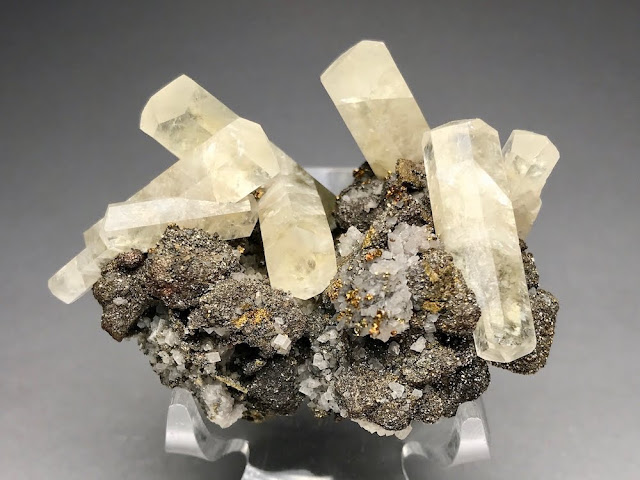バイバーナム・トレンドの方解石と方鉛鉱 Calcite and Galena from Viburnum Trend
Sweetwater Mine, Viburnum Trend, Reynolds County, Missouri, USA(アメリカ・ミズーリ州)
標本幅 width 6.5 cm / 重さ weight 94 g
アメリカ・ミズーリ州南東部にバイバーナム(ビバーナム)・トレンドと呼ばれる南北 50 km にもおよぶ帯状の鉛鉱床がある。ここで産出した鉱物標本をいくつか入手したので、まとめて紹介する。
Viburnum trend is a lead deposit in the southeast Missouri ranging 50 km from north to south. I have recently got some specimens from this locality.
まずはスイートウォーター鉱山の方解石標本(冒頭の写真)。教科書どおりの六角柱の結晶群で、色ははちみつのような薄黄色。両錐のものが多く、端面はいわゆる釘頭状である。内部にクラックがあるのが残念だが、標本の大きさ、結晶のくっつき方のバランスがよかった。
The starter is calcite from the Sweetwater mine (see the top photo), forming honey-yellow textbook hexagonal cylinders mostly double terminated.
It looks that the place where a galena crystal once existed became a void. There is also dolomite.
この標本の基盤部は方鉛鉱後のヌケガラのようだ。これはまず方鉛鉱の八面体結晶ができて、その後表面に細かい黄銅鉱が析出して中身の方鉛鉱がどこかにいってしまったもので、負の仮晶ともいわれる。日本の鉱脈型の鉱床では重晶石後のヌケガラ石英がしばしば見られるが、両者のでき方には共通点があるのだろうか? その他、よく観察すると金属光沢のある八面体結晶がいくつもみられる。この産地ではジーゲン鉱(シーゲン鉱 Siegenite; CoNi2S4)と呼ばれるコバルト・ニッケル鉱物が出るそうで、見た目からしてそれかもしれない。もしそうだとするとこの標本はみどころ満載である。
Calcite grew from chalcopyrite pseudomorph created after octahedral galena went away. This resembles quartz pseudomorph after baryte often found from vein-type metal mines in Japan. There are a number of tiny lustrous octahedral metal minerals, which might be siegenite since Sweetwater is known to produce this cobalt-nickel sulfide.
Octahedral crystals may be siegenite. Field of view is about 7 mm.
つぎはブラッシー・クリーク鉱山の方鉛鉱で、立方体結晶が2つ貫入しあっている。表面の光沢がとてもよい。結晶のすみっコが欠けている部分があるが、まあしかたない。
Next is galena from Brushy Creek mine. Two lustrous cubes penetrate each other.
標本高さ height 5.5 cm / 重さ weight 156 g
これも基盤部がおもしろい。なにかの八面体の結晶が多数寄せ集まって球体をつくって、その一部を苦灰石が覆う。一見黄銅鉱っぽくも見えるが、標本商によるとこれは黄鉄鉱の集合らしい。結晶軸に垂直な面が八面体の頂点に小さく出ていて、そこだけ白っぽく輝いている。いわゆる「黄鉄鉱ボール」というのがあるので、それに類するものかもしれない。
Galena crystals sit with dolomite on a ball made up of small octahedral crystals of, probably, pyrite. This may be a kind of the so-called "pyrite ball".
There are steps on the octahedron's surface. Field of view is 10 mm.
最後はフレッチャー鉱山の方鉛鉱。
The last one is also galena from Fletcher mine.
標本高さ height 4 cm / 重さ weight 15 g
細長く伸びた方鉛鉱が3本ほど平行に連なっている。方鉛鉱はふつう立方体、ちょっと細長くなったとしても豆腐みたいな形をしているものだが、これは縦横比が 1:8 くらいある。立方体を一軸方向に伸ばした、というよりは、もっと複雑なつくりをしていて、板状の双晶がある方向に異常に成長したもの、らしい。いまいちよくわからない。ここで紹介した3つの標本は、すべてミズーリ州の地元の標本商から手に入れた。このウェブサイトには同じような長柱状方鉛鉱がいくつも展示されている。
A couple of elongated galena crystals grow in parallel. Galena is usually close to a cube, but each crystal's aspect ratio is about 1:8 in this example. This is not a simply elongated cube, but rather a result of an extraordinary growth of twinned galena. I acquired these three pieces at a website of a mineral dealer in Missouri, where other similar galena specimens can be seen.
ミズーリ州南東部はもともと鉛地帯(the Lead Belt)と呼ばれ、鉛・亜鉛鉱床が広く分布している。歴史ある鉱山地帯で、古くはアメリカ独立前にフランス人の手によって開発が試みられたという。いわゆる「ミシシッピ・バレー型」鉱床群のひとつで、古生代の苦灰岩を母岩として比較的低温の熱水が作用してできた交代鉱床である。バイバーナム・トレンドは、周囲の多くの鉱山がすでに閉山していた1950〜60年代に順次発見された新鉱床で、現在も稼働中である。このあたりは金属元素の中でもとくに鉛が異常に濃集している。ジーゲン鉱が出ることからわかるとおりコバルトとニッケルの濃集がみられるのも特徴である。
The southeastern part of Missouri is known as a historical mining district, the Lead Belt, that began to be mined before the American Revolution. The ore field is a typical example of Mississippi Valley-type deposit. The Viburnum Trend is a new deposit found in 1950s-60s when other nearby lead mines were finishing. It is characteristic that lead and also cobalt and nickel are concentrated.
参考
-
Viburnum Trend と Sweetwater Mine に関する mindat.org の記事。大きな晶洞の壁から方解石の巨晶が生えて、カツオの一本釣りのあとの船みたいになっている写真があって興味深い。
-
Wikipedia の Southeast Missouri Lead District と フィリップ・フランソワ・ルノーの記事。18世紀ミズーリの鉛鉱山ではアフリカ人奴隷が使用されたという。そういえばタランティーノ監督の「ジャンゴ 繋がれざる者」で主人公は鉱山に売られていくが、もしかしたら鉛地帯の一鉱山だったかもしれない。
Wikipedia articles of Southeast Missouri Lead District and Philip François Renault. In the 18th century, African slaves worked at the lead mines in Missouri. In Django Unchained directed by Tarantino, the main character was forced to go to work as a miner. The mine might be one of such lead mines. -
帝国書院「新詳高等地図」(2008)より、「アメリカ合衆国・カナダの鉱工業」。ヴィバーナムで鉛がとれることが記されている。地理の大学入試問題でもここまでは出ないだろうな。









